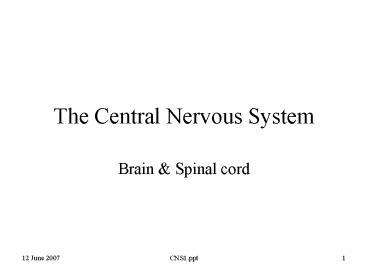The Central Nervous System - PowerPoint PPT Presentation
1 / 23
Title:
The Central Nervous System
Description:
Sinking of neural plate forms neural groove. Folds fuse to complete ... No capacity for anaerobic respiration. Brain cells die w/in 5-6 minutes when deprived ... – PowerPoint PPT presentation
Number of Views:19
Avg rating:3.0/5.0
Title: The Central Nervous System
1
The Central Nervous System
- Brain Spinal cord
2
Development of the CNS
- Similar in all "Amniotes"
- Blastoderm over yolk sac
- three "germ layers"
- Ectoderm ("outside skin")
- Mesoderm ("middle skin")
- Endoderm ("inner skin")
3
Nervous System Development
- Develops from Ectoderm
- Rising of neural folds
- Sinking of neural plate forms neural groove
- Folds fuse to complete neural tube
4
Nervous System Development
- Neural tube forms CNS (esp. spinal cord)
- Expands anteriorly to form brain
- Peripheral nerves develop from lateral "neural
crest" cells
5
Expansion of Brain
- Primary
- Forebrain
- Midbrain
- Hindbrain
6
Expansion of Brain
- Secondary
- Forebrain
- Telencephalon
- Diencephalon
- Midbrain
- remains just midbrain
- Hindbrain
- Cerebellum
- Brain stem
7
Expansion of Brain
- Final development
- Telencephalon cerebrum
- Diencephalon thalamus hypothalamus
- Cerebellum
- Brain stem Midbrain pons medulla oblongata
8
Protection Nutrition of CNS
9
Protection
- Bone
- Cranial bones vertebral arches
- Meninges
- Dura mater
- Arachnoid mater
- Pia mater
- Cerebrospinal fluid (CSF)
10
Meninges
- Dura mater
- Arachnoid mater
- Pia mater
11
Cerebrospinal fluid (CSF)
- Filtered from blood plasma in choroid plexuses
12
Cerebrospinal fluid (CSF)
- Filtered from blood plasma in choroid plexuses
- Circulates in through ventricles, canals,
between meninges - Returned to blood at superior sagittal sinus
13
Ventricles of the Brain
- 2 Lateral ventricles (1, 2) in cerebral
hemispheres - Third ventricle (3) between hemispheres
- Fourth ventricle (4) in midbrain and medulla
14
Cerebrospinal fluid (CSF)
- Supports (buoys) mass
- Cushions CNS - like waterbed
- Nourishes brain tissue
- Contains proper electrolytes for CNS
15
Blood supply Nutrition
- Brain is highly vascular
- blood delivers O2 and glucose supply
- Can't be deprived of O2. No capacity for
anaerobic respiration. - Brain cells die w/in 5-6 minutes when deprived
- Requires glucose (or ketone bodies) as fuel
- Can't use fats, amino acids.
16
Blood-brain barrier
- CNS is sensitive to chemicals
- Capillaries have thicker, non-leaky walls.
- Protects brain from drugs, metabolites, toxins
17
BRAIN
- Largest part of CNS
- Center of consciousness, communication
- Integrates sensory input
- Coordinates complex responses to environment
- Center of homeostatic regulation of nearly all
physiological processes. - Breathing, Heartbeat, Hunger/Satiety
- Reproductive "drive," Musculoskeletal coordination
18
Parts of the Brain
- In order evolved, from lower posterior to higher
anterior.
19
Brain Stem
- Superior continuation of spinal cord
- Medulla oblongata
- Pons (bridge)
- Midbrain
- Reticular formation
20
Medulla oblongata
- Conduction region for motor and sensory pathways
to from brain - Decussation
- Crossing of tracts/fibers to opposite sides
- Left brain controls right motor activity.
- Regulation of heartbeat force of contraction,
- " " breathing rhythm,
- " " blood flow through
arteries, - " " equilibrium (sense of
balance). - Origins of cranial nerves VIII - XII
21
Pons (bridge)
- Connections to other parts of brain
- transverse fibers to/from cerebellum
- longitudinal fibers to above/below
- Regulation of breathing
- Origins of cranial nerves V - VIII
22
Midbrain
- Conveys impulses to/from cerebrum
- Superior Inferior colliculi
- Reflex centers for movements of eyes, head,
torso in response to visual auditory stimuli - Tracking of moving objects
- Origins of cranial nerves III, IV
23
Reticular formation
- Deep structure of whole brain stem
- Reticular Activating System
- Regulates alertness, wakefulness sleep































